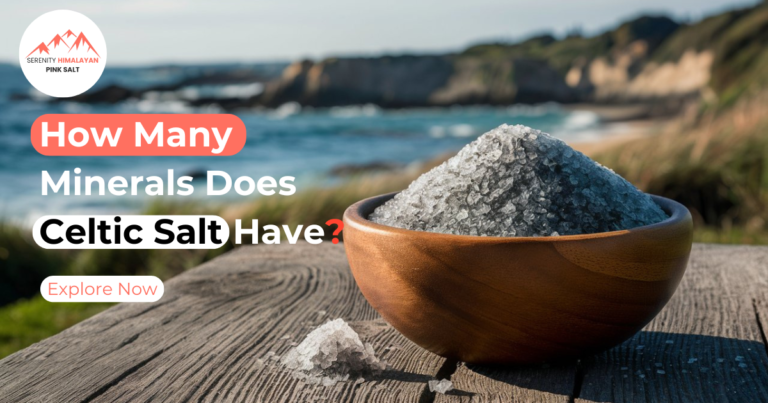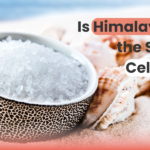Celtic salt, often called grey sea salt or sel gris, is renowned for its rich mineral content and numerous health benefits. This natural sea salt, harvested from the pristine coastal regions of Brittany, France, retains a distinct grey hue and moisture due to its unique harvesting process.
In this article, we explore the mineral composition of Celtic salt, its health advantages, and how it compares to other types of salts.
1. Celtic Salt
Celtic salt, celebrated for its distinctive color and texture, is hand-harvested using centuries-old methods that preserve its natural mineral content. Unlike refined table salt, which is stripped of minerals and often contains additives, Celtic salt is rich in essential nutrients and offers a more complex flavor profile. Its growing popularity in culinary and wellness communities stems from these unique characteristics.
2. Detailed Mineral Composition of Celtic Salt
Celtic salt contains a plethora of minerals that are vital for maintaining good health. Here’s a closer look at its composition:
Major Minerals
- Sodium (Na): Essential for regulating blood pressure, fluid balance, and nerve function.
- Chloride (Cl): Important for maintaining fluid balance and is a key component of digestive acids.
- Magnesium (Mg): Supports muscle and nerve function, bone health, and is involved in over 300 biochemical reactions in the body.
- Calcium (Ca): Crucial for bone and teeth health, as well as muscle function and nerve signaling.
- Potassium (K): Helps regulate fluid balance, muscle contractions, and nerve signals.
Trace Minerals
- Iron (Fe): Vital for the formation of hemoglobin and oxygen transport in the blood.
- Zinc (Zn): Supports immune function, wound healing, and DNA synthesis.
- Copper (Cu): Essential for iron metabolism, nervous system health, and the formation of red blood cells.
- Manganese (Mn): Involved in bone formation, blood clotting, and reducing inflammation.
- Selenium (Se): Acts as an antioxidant and plays a critical role in thyroid function.
- Iodine (I): Necessary for the production of thyroid hormones and metabolic regulation.
- Fluoride (F): Important for dental health and the prevention of tooth decay.
- Sulfur (S): Contributes to the structure of amino acids and the production of proteins.
- Phosphorus (P): Essential for energy production and the formation of bones and teeth.
- Bromine (Br): Plays a role in the maintenance of normal cellular functions.
Celtic salt is known to contain over 80 trace minerals, though the exact number can vary depending on the source and the specific conditions of the salt marshes where it is harvested.

3. Health Benefits of Celtic Salt
The diverse mineral content of Celtic salt offers a range of health benefits:
- Hydration: The electrolytes in Celtic salt, such as sodium and potassium, help maintain optimal hydration levels in the body.
- Digestive Health: Chloride aids in the production of hydrochloric acid in the stomach, facilitating digestion.
- Bone Strength: Minerals like calcium and magnesium are vital for maintaining strong and healthy bones.
- Improved Flavor and Nutrient Profile: The natural minerals enhance the taste of food and provide nutritional benefits not found in refined salts.
- Electrolyte Balance: Celtic salt helps maintain the balance of electrolytes, crucial for nerve and muscle function.
4. Traditional Harvesting Methods of Celtic Salt
Celtic salt is harvested using time-honored techniques that preserve its purity and mineral richness. Here’s how it’s done:
- Sea Water Collection: Sea water is channeled into shallow clay ponds or “salt pans” near the coast.
- Evaporation Process: The water is allowed to evaporate naturally under the sun and wind, concentrating the salt.
- Salt Raking: Once the water has evaporated, the salt is raked and collected by hand. This traditional method helps retain the moisture and trace minerals in the salt.
- Drying: The salt is then dried naturally, ensuring it remains slightly moist, which is a characteristic feature of Celtic salt.
These methods, passed down through generations, help maintain the integrity and quality of the salt, ensuring that it remains a natural and nutritious product.

5. Comparative Analysis: Celtic Salt vs. Other Salts
Celtic salt is often compared to other types of salts available on the market. Here’s a comparative look at how it stacks up:
| Type of Salt | Major Minerals | Trace Minerals | Processing |
| Celtic Salt | Sodium, Chloride, Magnesium | Iron, Zinc, Copper, Manganese, Selenium | Minimal processing, hand-harvested |
| Table Salt | Sodium, Chloride | Usually none, highly processed | Heavily processed, additives included |
| Himalayan Salt | Sodium, Chloride, Calcium | Iron, Potassium, Magnesium | Mined, minimal processing |
| Sea Salt | Sodium, Chloride | Varies depending on the source | Varies from minimal to moderate |
Celtic Salt vs. Table Salt: While table salt is typically stripped of all minerals except sodium and chloride, Celtic salt retains its natural array of minerals. Additionally, table salt often contains anti-caking agents and other additives.
Celtic Salt vs. Himalayan Salt: Both salts are minimally processed and contain a variety of minerals. However, Celtic salt has a higher moisture content and a distinct mineral profile due to its marine origin, while Himalayan salt is dry and pink-colored due to iron oxide.
Celtic Salt vs. Regular Sea Salt: The mineral content of sea salt can vary widely depending on its source. Celtic salt, harvested in specific conditions, is consistently rich in a broad spectrum of minerals.

6. Incorporating Celtic Salt into Your Diet
Celtic salt can be a versatile addition to your kitchen. Here are some ways to use it:
- Cooking: Add to soups, stews, and sauces to enhance their flavor and nutritional content.
- Finishing: Sprinkle on salads, meats, and vegetables as a finishing touch to bring out the natural flavors.
- Baking: Use in bread and pastry recipes to provide a richer taste.
- Hydration: Mix a pinch into your water bottle for a homemade electrolyte drink, especially beneficial during workouts.
- Seasoning: Incorporate into spice blends and rubs for an extra layer of flavor.
7. Conclusion
Celtic salt stands out as a nutritionally superior choice among salts due to its rich mineral content and natural harvesting process. Its unique composition not only enhances the flavor of your dishes but also provides essential nutrients that contribute to overall health. When choosing a salt for your culinary and wellness needs, consider the benefits of Celtic salt and how it can be a valuable addition to your diet.















One Response